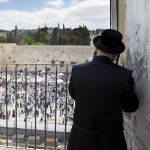“And you will say to them, ‘Thus says the Lord, If you will not listen to Me, to walk in My law which I have set before you, to listen to the words of My servants the prophets, whom I have been sending to you again and again, but you have not listened; then I will make this house like Shiloh, and this city I will make a curse to all the nations of the earth.’” (Jeremiah 26:4–6)
Tisha B’Av, the saddest day on the Jewish calendar (Av 9). It is a day of fasting on which we mourn the destruction of the First and Second Temples that stood on the Temple Mount in Jerusalem.
Babylon had successfully laid siege to Jerusalem without destroying the Temple around 605 BC, taking Daniel and many Israelites captive.
As well, the Prophet Jeremiah had very vocally warned the people of the coming siege for many years. He repeatedly called for repentance, which could have prevented the destruction of the Temple.
In Jeremiah 36:1–24, the prophet had even written God’s warning in a scroll, which was read aloud before the Temple court.
Then, it was read to King Jehoiakim, a king who vacillated between paying tribute to Egypt and then Babylon, and then Egypt again when it appeared to be more powerful than Babylon.
As a show of defiance, Jehoiakim burned the scroll and unsuccessfully tried to take Jeremiah captive. (Jeremiah 36:26)
Like so many of us do in the face of a word of correction, or something we consider an affront, the king wanted to silence the messenger.
God then instructed Jeremiah to rewrite the warning on a second scroll, calling again for repentance. He also added the following prophecy:
“Also tell Jehoiakim king of Judah, ‘This is what the Lord says: You burned that scroll and said, “Why did you write on it that the king of Babylon would certainly come and destroy this land and wipe from it both man and beast?”‘ Therefore this is what the Lord says about Jehoiakim king of Judah: ‘He will have no one to sit on the throne of David; his body will be thrown out and exposed to the heat by day and the frost by night. I will punish him and his children and his attendants for their wickedness; I will bring on them and those living in Jerusalem and the people of Judah every disaster I pronounced against them, because they have not listened.'” (Jeremiah 36:29–31)
With this, Jeremiah prophesied both the destruction of Jerusalem, the death of Jehoiakim, and the demise of his line on the throne of David.
Tisha B’Av and Israel’s Last King
In about 600 BC, when Jehoiakim stopped paying tribute to Nebuchadnezzar in the hopes of forming an alliance with Egypt, Babylon once again laid siege to Jerusalem.
Just two years later, Jehoiakim died. In fulfillment of Jeremiah’s prophecy, Jehoiakim’s son Jehoiachin (Jeconiah) sat on the throne for just over three months before Nebuchadnezzar deposed him, ending the reign of Jehoiakim’s descendants (2 Chronicles 36:8–9; 2 Kings 24:8).
Nebuchadnezzar then plundered the Temple, exacting an oath of loyalty from Zedekiah, whom he placed on the throne.
He returned to Babylon with Jeconiah as prisoner, along with the elite of the people, including the Prophet Ezekiel.
During this time, Jeremiah worked to help the people understand that their exile was God’s judgment for having turned away from Him and His laws. He continuously implored them to repent wholeheartedly.
Jeremiah prophesied to the exiles that God would return them to Jerusalem in 70 years. In the meantime, he instructed them to rebuild their lives and be good citizens of Babylon.
He sent them the following message:
“Build houses and live in them; and plant gardens and eat their produce. Take wives and become the fathers of sons and daughters, and take wives for your sons and give your daughters to husbands, that they may bear sons and daughters; and multiply there and do not decrease. Seek the welfare of the city where I have sent you into exile, and pray to the LORD on its behalf; for in its welfare you will have welfare. … For thus says the LORD, ‘When seventy years have been completed for Babylon, I will visit you and fulfill My good word to you, to bring you back to this place.'” (Jeremiah 29:5–10)
A discovery in 2015 of cuneiform tablets dating 572–477 BC revealed that the Jewish People did indeed rebuild their lives in Babylon, buying, selling, and trading in cities that they named, such as Al-Yahudu (City of Judah).
Though Zedekiah pledged loyalty to Nebuchadnezzar, he revolted against Babylon (against Jeremiah’s advising). Nebuchadnezzar again laid siege to Jerusalem for two and a half years.
Hoping to reverse the consequences of his actions, Zedekiah asked Jeremiah to pray that God would deliver them from the invading forces. The prophet told Zedekiah to surrender for his children’s sake and for the people of the city, but he refused, throwing Jeremiah instead into a dungeon.
Nebuchadnezzar suddenly withdrew because he heard that Egyptian forces were marching against him, but Jeremiah prophesied that he would return.

On Tisha B’Av, Jewish men pray and read, kneeling and seated on the ground at the Western (Wailing) Wall, which is just below the Temple Mount in the Old City of Jerusalem.
He continued to warn about the upcoming destruction, which apparently lowered morale among the soldiers. Following Jeremiah’s instructions would have relieved the impending doom; instead, Zedekiah allowed officials to throw him into a waterless cistern where he sank into the mud.
Yet, God saved Jeremiah’s life when a Cushite pleaded on his behalf before the king and attained his release.
“This is what the LORD God Almighty, the God of Israel, says: ‘If you surrender to the officers of the king of Babylon, your life will be spared and this city will not be burned down; you and your family will live. But if you will not surrender to the officers of the king of Babylon, this city will be given into the hands of the Babylonians and they will burn it down; you yourself will not escape from them.’” (Jeremiah 38:17–18)
Like many people, Zedekiah’s great downfall was his fear of man over God. He told Jeremiah,
“I am afraid of the Jews who have gone over to the Babylonians, for the Babylonians may hand me over to them and they will mistreat me.” (Jeremiah 38:19)
Fearing the people more than the God of Israel, Zedekiah did not surrender to Babylon.
Consequently, in the 11th year of Zedekiah’s reign, the city wall was breached. By this time, many had died from starvation and sickness. Zedekiah fled through a tunnel but was captured on the plains of Jericho.
In fulfillment of Jeremiah’s final, unheeded warning, Zedekiah was taken captive and forced to witness the death of his own sons before the Babylonians gouged out his eyes and led him in bronze chains to Babylon.
The walls of Jerusalem were torn down and the city was set on fire, including the royal palace.
The destruction of the Temple came toward evening on the 9th of Av after all of its treasures had been removed and taken as booty to Babylon.
Many were killed and thousands were taken into captivity. Only the poorest of the poor were allowed to remain, and they were given vineyards and fields (Jeremiah 39:10).
As a consequence of sin, Zedekiah became the last king of Judah, and all that Jeremiah prophesied was fulfilled and continues to be fulfilled.
The Restoration of the Jewish People to Their Homeland
The First Temple stood for 410 years but was destroyed because of the sins of murder, immorality, and idolatry.
Nevertheless, God is merciful. As prophesied by Jeremiah, the Jewish People returned to the Holy City after 70 years, and the people rebuilt the Temple.
This Second Temple lasted 420 years until it, too, was destroyed by the Romans, just as prophesied by Yeshua (Jesus) in Matthew 24:2. Like the First Temple, it was destroyed on Tisha B’Av—but this time (according to Jewish tradition) for the sin of baseless hatred (sinat chinam) among the Jewish People.
Jeremiah had also foreseen the destruction of the Second Temple and the exile of the Jewish People into the nations (Jeremiah 23:1–4).
Still, he understood that God would bring the exiles back, once again:
“I Myself will gather the remnant of My flock out of all the countries where I have driven them and will bring them back to their pasture, where they will be fruitful and increase in number. I will place shepherds over them who will tend them, and they will no longer be afraid or terrified, nor will any be missing.” (Jeremiah 23:3–4)
Adonai Tzidkenu, the Lord Our Righteousness Will Return
In these last days, in fulfillment of the prophecies of Jeremiah and other Hebrew prophets, we have witnessed the return of many Jewish people to the Promised Land—a country in the midst of a battle to preserve the Jewish heritage in its own homeland.
But Jeremiah also saw a future King and Priest, the Righteous Branch, who is Yeshua HaMashiach (Jesus the Messiah).
This Righteous Branch is called Adonai Tzidkenu, the Lord our Righteousness, one of the revealed names of God!
“‘Behold, the days are coming,’ declares the LORD, ‘When I will raise up for David a Righteous Branch [צֶ֣מַח צַדִּ֑יק]; and He will reign as king and act wisely and do justice and righteousness in the land.
‘In His days Judah will be saved, and Israel will dwell securely; and this is His name by which He will be called, “The LORD our Righteousness [Adonai Tzidkenu].”’” (Jeremiah 23:5–6)
Believers in Yeshua know that Adonai Tzidkenu, The Lord our Righteousness, has come and brought salvation to His people.
We know that He will soon return to a rebuilt Temple in Jerusalem.
“This same Yeshua, who has been taken from you into Heaven, will come back in the same way you have seen Him go into Heaven.” (Acts 1:11)
In fact, the Temple Institute, which has already created the vessels for the Third Temple and has drawn up the blueprints for the structure.
It has also established a training school for the Cohanim (priests) and has received and is examining Red Heifers to see if any will meet the standards required to purify the priests for Temple service.
The prophecies of Jeremiah concerning the First Temple and the exile in Yeshua’s day have been fulfilled, and even today we see that those prophecies are continuing to be fulfilled with the return of the Jewish People to their land.
As we remember the destruction of the First and Second Temples on Tisha B’Av with a day of fasting, mourning, and repentance for sin, we can also look forward to the day when all Israel will be saved and Yeshua, Adonai Tzidkenu, returns.
“Hear the word of the LORD, you nations; proclaim it in distant coastlands: ‘He who scattered Israel will gather them and will watch over His flock like a shepherd.’” (Jeremiah 31:10)



















